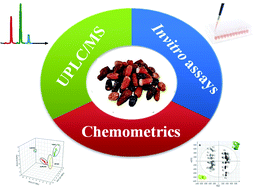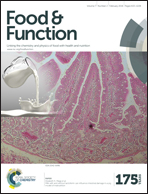Metabolite profiling in 18 Saudi date palm fruit cultivars and their antioxidant potential via UPLC-qTOF-MS and multivariate data analyses†
Abstract
Date palm fruit (Phoenix dactylifera) is not only one of the most economically significant plants in the Middle East, but also valued for its nutritional impact, and for which development of analytical methods is ongoing to help distinguish its many cultivars. This study attempts to characterize the primary and secondary metabolite profiles of 18 date cultivars from Saudi Arabia. A total of 44 metabolites extracted from the fruit peel were evaluated in a UPLC-qTOF-MS based metabolomics analysis including flavonoids, phenolic acids and fatty acids. The predominant flavones were glycosides of luteolin and chrysoeriol, as well as quercetin conjugates, whereas caffeoyl shikimic acid was the main hydroxycinnamic acid conjugate. GC-MS was further utilized to identify the primary metabolites in fruits (i.e. sugars) with glucose and fructose accounting for up to 95% of TIC among most cultivars. PCA and OPLS analyses revealed that flavone versus flavonol distribution in fruit were the main contributors for cultivar segregation. The antioxidant activity of date fruit samples was correlated with their total phenolics as determined by DPPH and CUPRAC assays. Dkheni Saudi and Shalabi Madina cultivars, appearing as the most distant in clustering analyses exhibited the strongest antioxidant effect suggesting that multivariate data analysis could help determine which date cultivars ought to be prioritized for future agricultural development.


 Please wait while we load your content...
Please wait while we load your content...